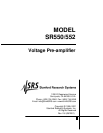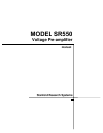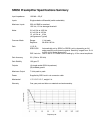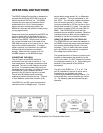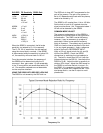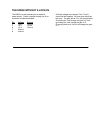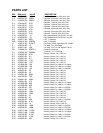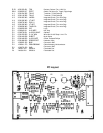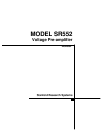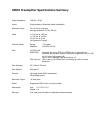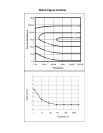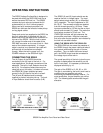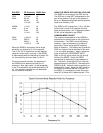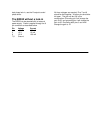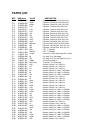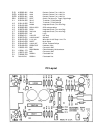
DYN RES FS Sensitivity SR552 Gain
LOW > 50 mV 10
20 db 50 mV 20
20 mV 50
< 20 mV 100
NORM > 5 mV 10
40 db 5 mV 20
2 mV 50
< 2 mV 100
HIGH > 500 µV10
60 db 500 µV20
200 µV50
< 200 µV 100
When the SR552 is connected, the full scale
sensitivity can extend to 10 nV (no expand).
The 10, 20, 50 nV sensitivities can be reached
using the normal lock-in controls. If the SR552
is disconnected while the sensitivity is below 100
nV, the sensitivity will revert back to 100 nV.
From the computer interface, the presence of
the SR552 can be determined using the 'H'
command. Also, gain codes 1-3 are acceptable
in the 'G' command to set sensitivities below 100
nV. Pre-amplifier overloads are not detectable
via the computer interface.
USING THE SR552 WITH SRS DSP LOCK-INS
The SR552 is not sensed by the DSP lock-ins.
The DSP lock-in does NOT compensate for the
gain of the preamp. The gain of the preamp is
set to 10. Measurements made with the preamp
need to be divided by 100.
The SR552 is AC coupled from 1 Hz to 100 kHz.
Set the lock-in input to AC coupled since the
signal must be above 1 Hz. Frequencies below 1
Hz will not be detected by the SR552.
COMMON MODE ADJUST
The common mode rejection of the SR552 is
adjusted by the small screw on the right side of
the enclosure. The CMR is set at the factory,
however, it may be necessary to re-adjust it,
particularly if there is one specific frequency
which is important. The easiest way to peak the
CMR is to use the internal oscillator of the lock-
in (or any signal generator). Apply a reference
signal to the lock-in REFERENCE INPUT.
Apply a 100 mV signal to both the (A) and (B)
inputs of the SR552. Check the SR552
connections by switching the input selector to
(A). The lock-in should read 100 mV (with the
phase adjusted on the SR510). Now switch the
SR552 to (A-B). Adjust the lock-in sensitivity to
obtain a 50% output. Adjust the CMR screw on
the SR552 to minimize the lock-in output. On
the SR510, it is necessary to check the output
when 90° of phase shift is added as well. On a



